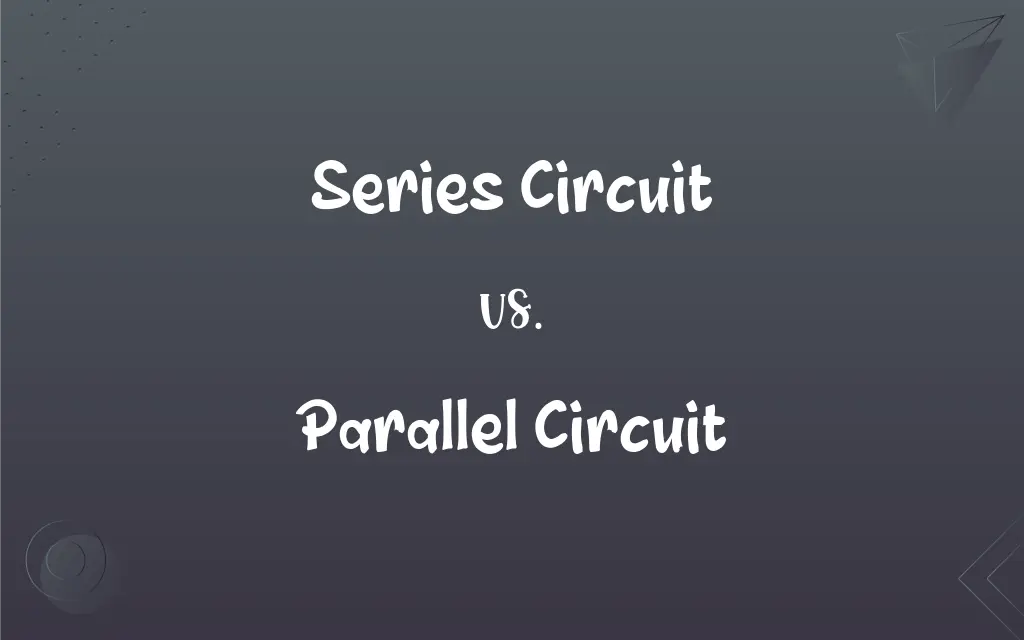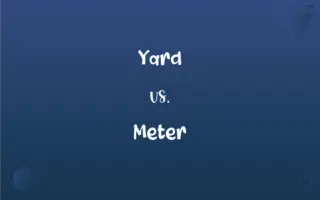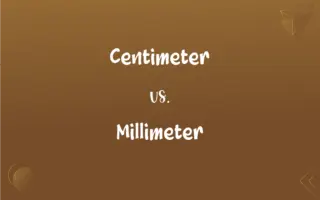Series Circuit vs. Parallel Circuit: What's the Difference?
Edited by Aimie Carlson || By Harlon Moss || Updated on October 24, 2023
In a series circuit, components are connected end-to-end, whereas in a parallel circuit, components are connected across common points or junctions.

Key Differences
In the realm of electronics, the concepts of series circuit and parallel circuit play pivotal roles. A series circuit refers to a configuration where all the components, like resistors or bulbs, are connected end-to-end, forming a single path for the current to flow. In contrast, a parallel circuit describes a configuration where the components are connected across common points or junctions, offering multiple paths for the current.
Diving deeper, in a series circuit, the same current flows through all components. This means that if one component fails (like a burnt bulb), the entire circuit is interrupted, causing all components to stop functioning. On the other hand, in a parallel circuit, each component has its own separate loop and receives the full voltage supply. If one component fails, others continue to operate normally because they're on different loops.
From a voltage perspective, the total voltage in a series circuit gets divided among the components, while in a parallel circuit, each component gets the full supply voltage. This characteristic makes parallel circuits common in household wiring, ensuring that each device gets the necessary voltage regardless of the number of devices connected.
Another notable distinction lies in resistance. In a series circuit, resistances add up, increasing the circuit's total resistance. Conversely, in a parallel circuit, the total resistance decreases as more resistors are added, which can lead to higher currents and the potential need for safety precautions.
In essence, series and parallel circuits present unique behaviors in terms of current, voltage, and resistance. A series circuit is characterized by a single pathway and dependent components, while a parallel circuit offers independent multiple pathways, with components that don't influence each other's functionality.
ADVERTISEMENT
Comparison Chart
Configuration
Components connected end-to-end.
Components connected across common points/junctions.
Current Flow
Same current flows through all components.
Different currents in different branches.
Voltage Across Components
Divided among components.
Same across all components.
Effect of a Component Failing
Entire circuit stops.
Remaining components continue to operate.
Total Resistance (with more resistors)
Increases.
Decreases.
ADVERTISEMENT
Series Circuit and Parallel Circuit Definitions
Series Circuit
Has cumulative resistance.
Adding more resistors to a series circuit increases the total resistance.
Parallel Circuit
Components are connected across common points.
In a parallel circuit, if one bulb goes out, the others remain lit.
Series Circuit
Voltage divides among components.
In a series circuit with three identical resistors, each resistor experiences one-third of the total voltage.
Parallel Circuit
Each branch has its own current.
Different branches of a parallel circuit might have different current values.
Series Circuit
All components share the same current.
A single current value can be measured anywhere in the series circuit.
Parallel Circuit
Components operate independently.
Devices in household wiring are typically connected in a parallel circuit for independent operation.
Series Circuit
Components are connected in a single path.
If one bulb goes out in a series circuit, all other bulbs will also go out.
Parallel Circuit
All components experience the full source voltage.
Every branch in a parallel circuit experiences the same voltage as the source.
Series Circuit
Failure in one component disrupts the whole circuit.
In a series circuit of batteries, if one battery dies, the entire circuit stops working.
Parallel Circuit
Total resistance decreases with more branches.
Adding more resistors in parallel reduces the circuit's overall resistance.
FAQs
What happens in a parallel circuit if one component fails?
In a parallel circuit, if one component fails, the others continue to operate normally.
How are components connected in a series circuit?
In a series circuit, components are connected end-to-end, forming a single path.
How does current behave in a series circuit?
In a series circuit, the same current flows through all components.
Are household appliances usually connected in series or parallel?
Household appliances are usually connected in parallel.
What happens to the total voltage in a parallel circuit?
In a parallel circuit, each component gets the full supply voltage.
What is a main disadvantage of parallel circuits in terms of energy consumption?
Parallel circuits might draw more total current, potentially leading to higher energy consumption.
How does voltage behave in a series circuit?
In a series circuit, the voltage divides among the components.
What's the advantage of using parallel circuits in home wiring?
In home wiring, parallel circuits ensure each device gets the full supply voltage and operate independently.
Why are parallel circuits preferred for household lighting?
Parallel circuits are preferred because they allow bulbs to operate independently and provide each bulb with full voltage.
Can a combination of series and parallel connections be used in a circuit?
Yes, complex circuits can have both series and parallel connections, known as mixed or combination circuits.
How does the total current in a parallel circuit compare to the branch currents?
In a parallel circuit, the total current is the sum of the currents in each branch.
Why are series circuits often used in battery configurations?
Series circuits in batteries can increase the total voltage, with each battery adding its voltage to the circuit.
How does resistance behave in a parallel circuit when more resistors are added?
In a parallel circuit, as more resistors are added, the total resistance decreases.
Why might series circuits be used in certain applications?
Series circuits might be used when it's crucial for components to share the same current or when dependent operation is desired.
In which circuit, series or parallel, is the total resistance less than the smallest resistor's resistance?
In a parallel circuit, the total resistance can be less than the smallest resistor's resistance.
How do you calculate the total resistance in a series circuit?
In a series circuit, the total resistance is the sum of the individual resistors.
How do you calculate the total resistance in a parallel circuit?
In a parallel circuit, the reciprocal of the total resistance is the sum of the reciprocals of each resistor.
What is the effect on current in a parallel circuit when more branches are added?
In a parallel circuit, adding more branches can increase the total current drawn from the source.
What's a disadvantage of series circuits in practical applications?
A disadvantage of series circuits is that if one component fails, the entire circuit is interrupted.
In which circuit, series or parallel, does adding more components increase the total resistance?
In a series circuit, adding more components increases the total resistance.
About Author
Written by
Harlon MossHarlon is a seasoned quality moderator and accomplished content writer for Difference Wiki. An alumnus of the prestigious University of California, he earned his degree in Computer Science. Leveraging his academic background, Harlon brings a meticulous and informed perspective to his work, ensuring content accuracy and excellence.
Edited by
Aimie CarlsonAimie Carlson, holding a master's degree in English literature, is a fervent English language enthusiast. She lends her writing talents to Difference Wiki, a prominent website that specializes in comparisons, offering readers insightful analyses that both captivate and inform.































































